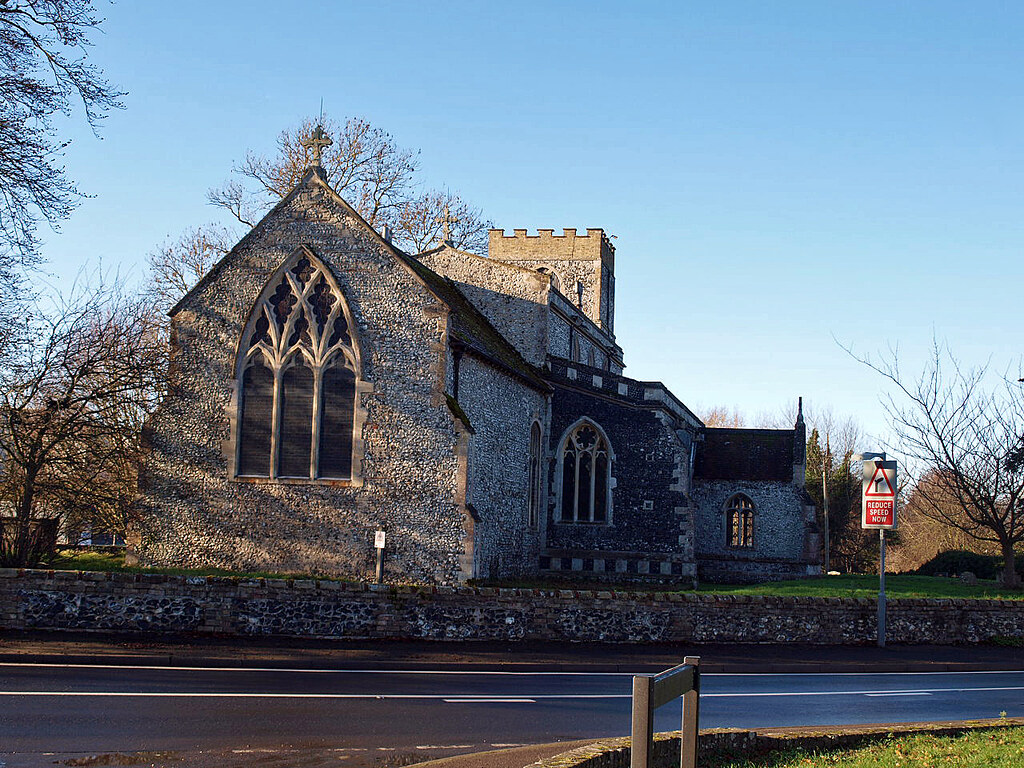ST JAMES, Chancel of c. 1300, see the E window with cusped intersected tracery and the odd motif of three arches at the foot of the intersecting part. The rest Perp, but with re-used Dec windows. Perp arcades, the piers with polygonal attachments towards the nave and aisles which have no capitals. - FONT. Octagonal, Perp, simple. - (STALLS. They incorporate parts of the rood screen. L G) - PLATE. Elizabethan Cup; Paten probably Elizabethan.
ICKLINGHAM. Almost lost among the trees by the River Lark, it is a charming place with the distinction of having two old churches, both medieval. It has a modern hall in Italian style, in a garden fragrant with roses when we called; and it has seen the discovery, about a mile from All Saints Church, of one of the houses of the Roman settlement here, the foundations of a villa being found, with pottery and coins and part of a furnace.
St James’s Church is mostly 500 years old, and has two astonishing gargoyles on the south side. Two doorways and one of the windows, however, may have belonged to an older building, and in the chancel there is some 14th century masonry. The font is 15th century, and so are the chancel arch and the curiously shaped pillars in the nave. Here still are the rood loft stairs up which the parson would go to give out the good news before the Reformation. Over the chancel is a modern wagon roof with 130 little bosses carved with faces and flowers. A window showing the Presentation in the Temple is a tribute to James Benstead, who served this place as churchwarden for 60 years of last century.
Shaded by tall trees half a mile away is All Saints, with a sturdy tower 600 years old, an ancient thatched roof, and a gracious 15th century south porch. A door on the north side has a quaint iron handle with a cross above a heart and an anchor to lift the latch. Much of the building is 14th century, including the wide south aisle, the four lovely arches dividing it from the nave, and the chancel arch. But the chancel has kept some Norman masonry in its walls, and the nave has two Norman windows blocked up. In other windows are fragments of 14th century glass showing rich canopies, three lovely figures and parts of two others, and touches of crimson and gold. The chancel has medieval tiles with birds and beasts and faces, a trefoiled piscina, sedilia made from a low window sill, and the lower part of a 15th century screen built on to a great oak beam over which we have to step. The south aisle has an attractive east window, and a cornice richly carved with ballflower and oak leaves. It has also a cinquefoiled piscina, and two elaborate niches, one with diaper work and one with traces of painting. The 14th century font is adorned with window tracery. The pulpit is an old three-decker cut down and spoiled; but All Saints has another piece of old woodwork which is one of the best things of its kind we have seen, a chest said to be six centuries old, covered with magnificent ironwork fashioned by some imaginative blacksmith of long ago into a pattern of nearly 100 circles; the lid alone has 40 circles, with cloverleaf centres.
Icklingham shares a peace memorial with Elveden and Eriswell, the great column set up by Lord Iveagh in 1921. It stands near the highroad where the three parishes meet, and the names of the fallen are facing the villages to which they never returned.

No comments:
Post a Comment